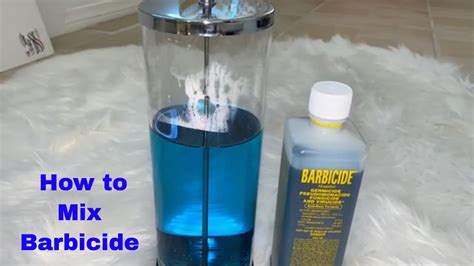Simple Steps to Perfect Barbicide Dilution: A Comprehensive Guide
Maintaining proper sanitation is paramount in any professional barbering or cosmetology setting. Barbicide, a powerful disinfectant, plays a crucial role in this process. However, using it incorrectly can compromise its effectiveness and even damage tools. This comprehensive guide outlines simple steps to ensure you achieve the perfect Barbicide dilution every time, maximizing its disinfecting power while protecting your equipment.
Understanding the Importance of Accurate Dilution
Barbicide, primarily a solution of glutaraldehyde, is potent. Using it at the wrong concentration can lead to several problems:
- Ineffective Disinfection: Too weak a solution won't kill harmful bacteria, viruses, and fungi, increasing the risk of infection for your clients.
- Tool Damage: Too strong a solution can corrode metal tools, dull blades, and damage the finish of other implements.
- Regulatory Non-Compliance: Incorrect dilution can lead to non-compliance with health and safety regulations, resulting in potential penalties.
The Recommended Barbicide Dilution Ratio
The standard recommended dilution for Barbicide is 1:10. This means one part Barbicide concentrate to ten parts water. Let's break down how to achieve this perfectly:
How to Dilute Barbicide: A Step-by-Step Guide
1. Gather Your Supplies:
- Measuring Cup or Cylinder: Using a graduated measuring cup ensures accuracy. Avoid using random containers.
- Barbicide Concentrate: Ensure you are using the correct Barbicide product and that the bottle is unopened or properly sealed.
- Clean Water: Use clean, cool tap water. Distilled water isn't necessary, but it can extend the life of the solution if you live in an area with hard water.
- Mixing Container: Choose a container appropriate for your disinfection needs, ensuring it's clean and free from residue. Wide-mouth containers are generally easier to use.
2. Measuring the Barbicide Concentrate:
Using your measuring cup, carefully measure the desired amount of Barbicide concentrate. For a typical batch, you might start with 1 ounce (30 ml) of concentrate. Remember, this will produce a 10-ounce (300ml) solution.
3. Adding the Water:
Next, add 9 ounces (270 ml) of clean water to the mixing container. It's typically easier to add the water first before pouring in the concentrate.
4. Mixing the Solution:
Gently swirl the container to thoroughly mix the Barbicide concentrate and water. Avoid vigorous shaking, as this can create foam and doesn't improve the mixing process.
5. Labeling and Storage:
Once mixed, clearly label your container with the following information:
- Contents: "Barbicide Disinfectant Solution"
- Dilution Ratio: "1:10"
- Date of Preparation: This ensures you don't use outdated solution.
- Discard Date: Barbicide solutions have a limited shelf life, so note the date after which the solution should be discarded (usually 14-28 days).
Store your diluted Barbicide solution in a cool, dark place away from direct sunlight and heat.
Frequently Asked Questions (PAA)
How long does Barbicide solution last?
The shelf life of a diluted Barbicide solution is typically 14 to 28 days, depending on the storage conditions. Always refer to the manufacturer's instructions for the precise timeframe. Once the solution becomes cloudy or discolored, it's time to discard it.
Can I reuse Barbicide solution?
No, Barbicide solution should not be reused after it has been used to disinfect tools. Its effectiveness diminishes over time and after coming into contact with contaminated items.
What should I do if I accidentally use the wrong dilution?
If you suspect you used an incorrect dilution (either too weak or too strong), immediately discard the solution. Reprepare a fresh batch using the correct 1:10 ratio. Contact your local health department if there are concerns about client exposure.
What are the signs that my Barbicide solution is no longer effective?
Signs of ineffective Barbicide include a cloudy or discolored solution, a change in odor, and a noticeable lack of disinfecting power. Always err on the side of caution and discard any solution that shows signs of degradation.
What should I do if Barbicide gets in my eyes?
In the event of accidental eye contact, immediately flush your eyes with plenty of water for at least 15 minutes. Seek medical attention if irritation persists.
Conclusion:
Mastering the art of proper Barbicide dilution is crucial for maintaining a safe and hygienic environment in your barbering or cosmetology practice. By following these simple steps and understanding the importance of accurate measurements and proper storage, you can ensure your tools are thoroughly disinfected, protecting both yourself and your clients. Remember to always refer to the manufacturer's instructions and follow all relevant health and safety regulations.

